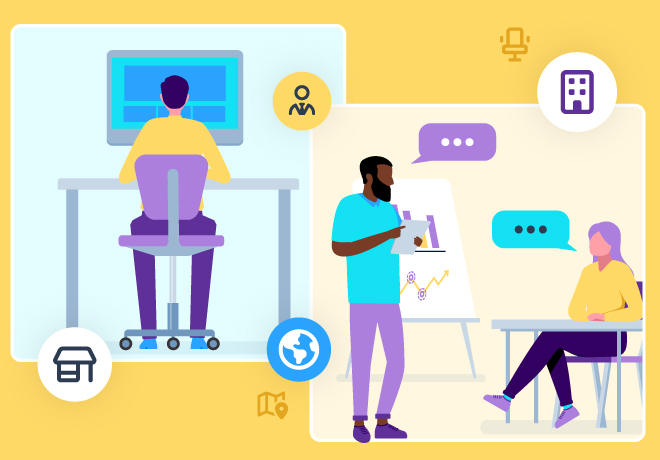
How Blended Learning Enhances Training for a Hybrid Workforce

Related articles
Get valuable eLearning insights to your inbox.
Listen to Neovation’s Demystifying eLearning podcast generated with NotebookLM!
Listen to our podcast on your favorite platform!
The modern workforce is no longer confined to a single building. Today’s teams are a dynamic mix of on-site employees collaborating in the office and remote colleagues connecting from around the globe. This is precisely the problem that blended learning is designed to solve.
Blended learning combines flexible, self-paced online materials with the irreplaceable value of live, instructor-led interaction, which can happen either in a physical classroom or a virtual one.
By merging the convenience of digital resources with essential human connection, blended learning offers the ideal solution to train a dispersed, hybrid workforce, ensuring every employee receives a high-impact education that is both consistent and personalized.
What Is Blended Learning?
Blended learning is a training approach that combines flexible online learning with live, in-person instruction. Sometimes called hybrid or web-enhanced learning, its key feature is that self-paced online activities replace some traditional classroom time, rather than just adding to it.
When combined with instructional design, blended learning can help employees learn new information through an online course on their own schedule, then join a live workshop to practice those skills with an instructor. This model of blended classroom learning gives remote staff flexibility while providing all employees with the benefits of hands-on collaboration.
Benefits of blended learning for organizations
Imagine a training program that costs less, engages more employees, and delivers better, lasting results—that is the power of a blended learning strategy.

- Higher engagement: Keeps employees focused by mixing self-paced online work with live, interactive sessions.
- Better knowledge retention: Uses online modules to cover foundational concepts, reserving valuable live time for hands-on practice and reinforcement.
- Increased training ROI: Reduces costs for travel and venues while improving learning outcomes, maximizing the impact of your training budget.
- Greater accessibility: Makes training inclusive and available to all employees, regardless of their location or time zone.
- Actionable performance data: Provides real-time data on learner progress to track effectiveness and instantly identify knowledge gaps.
Ultimately, these blended learning benefits allow you to build a more skilled and engaged workforce in a more efficient and cost-effective way.
Creating Blended Learning for a Hybrid Workforce
A blended strategy is the key to unlocking consistent, adaptable training for a dispersed team. Proper blended learning design directly solves the biggest hybrid work challenges:
Learning personalization at scale
Blended learning allows you to move beyond one-size-fits-all programs and tailor training to the individual.
- Self-paced modules: Let employees master core concepts on their own schedule.
- Live support: Use instructor-led training to address specific questions and individual needs.
- Adaptive paths: Customize content and activities based on job roles, departments, or identified skill gaps.
Consistency across locations
Ensure every employee receives the same high-quality training, no matter where they work.
- The formula: Standardized digital content for core knowledge + Live sessions for customized reinforcement. This guarantees equal access to information while allowing for discussions on location-specific challenges.
Engagement through interactivity
Keep both remote and on-site learners focused by building a dynamic experience. Go beyond static text by incorporating:
- Gamified quizzes and simulations
- Engaging videos and short-form content
- Peer-to-peer collaboration and breakout rooms By mixing formats, you maintain attention, boost participation, and improve knowledge retention for everyone.
Key Blended Learning Models Used in Corporate Training
To find the best blended learning approach for your goals, consider these five effective blended learning examples:
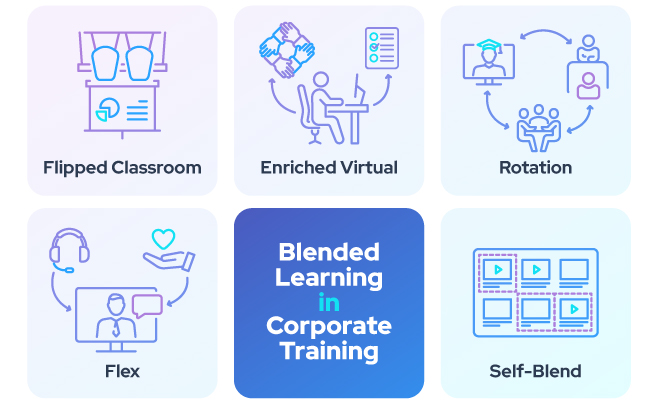
The Flipped Classroom Model
Employees learn foundational concepts through self-paced online modules, reserving valuable live sessions for hands-on practice, collaboration, and problem-solving. This model is perfect for turning passive lectures into active, applied learning.
The Enriched Virtual Model
Training is delivered primarily online, but all learners attend mandatory in-person sessions for crucial activities like team-building or final assessments. This is best for programs that need remote flexibility but have essential, high-touch requirements.
The Rotation Model
Learners cycle through a fixed schedule of varied activities, such as independent eLearning, small-group projects, and one-on-one mentoring. This approach keeps training dynamic and caters to different learning styles.
The Flex Model
Employees drive their own learning through a digital platform at their own pace, with instructors available for on-demand support. This model is built for fostering autonomy and is ideal for self-motivated learners.
The Self-Blend Model
Employees voluntarily supplement their required training by choosing from a library of optional online courses. This empowers self-driven professional development and continuous upskilling.
Tools and Technologies Powering Blended Learning
The right tech stack is the engine for any modern blended learning program. Here are the essential components:
- Learning Management Systems (LMS): The central hub for hosting content, tracking progress, and managing your blended learning courses. An LMS like MyCanvas delivers a personalized experience by automating content delivery and facilitating online community discussions.
- Digital Adoption Platforms (DAP): In-app guidance tools that help employees learn new software in real-time. A platform like Whatfix provides interactive walkthroughs and safe "sandbox" environments to improve software proficiency on the job.
- Authoring Tools: Software used to build custom, interactive eLearning courses. Tools like the Articulate 360 suite transform static documents into engaging modules with quizzes, scenarios, and consistent branding.
- Video & Webinar Platforms: Essential for live, virtual instructor-led training (vILT). Platforms such as Zoom and MS Teams enable real-time collaboration and allow sessions to be recorded for later review.
- Analytics and Reporting: The systems and standards used to measure training impact. Data from LMS dashboards helps prove ROI, while standards like SCORM and xAPI ensure learning activities are tracked accurately across all platforms.
Now that we've covered the theory and tools, let's examine how these concepts deliver measurable, real-world impact in our upcoming case study.
A Real-World Blended Learning Success Story
Neovation Learning Solutions partnered with Canada Soccer to solve the challenge of training over 32,000 coaches nationwide. Their traditional in-person model was logistically unsustainable, and a forced shift to online-only webinars during the pandemic proved ineffective and lacked engagement.
The solution was a blended learning approach that combined foundational eLearning courses with essential, hands-on, on-field workshops. Our custom instructional design team leveraged our SmarterU LMS to automate the entire process, from registration and content delivery to progress tracking and reporting, which drastically reduced administrative work. This strategic shift yielded remarkable results:
- A 733% increase in revenue.
- A 50% reduction in total training time per learner.
- Widespread adoption by over 32,000 members.
- Significant cost savings and a stronger, empowered community of local coaches
Your Blueprint for Training Success
In the age of hybrid work, blended learning is the definitive solution for effective corporate training. It strategically combines the scalability of digital tools with the irreplaceable impact of human connection.
As the Canada Soccer success story proves, this approach delivers programs that are not only more engaging and efficient but also produce powerful, measurable business results.
Ready to achieve these results for your own team? Neovation's Custom Learning team partners with organizations like yours to design and build effective blended learning strategies that deliver real impact.

Alex is an experienced writer and marketer with an interest in all things education. With a background in literary theory, technical writing, and document design, he is interested in how learners make meaning from language and how to create meaningful connections through writing.
Become part of our L&D community
We publish a new learning hub article — full of useful, practical topics — weekly.
Not sure where where you want to start? Jump into one of our recently published articles and see where it takes you!




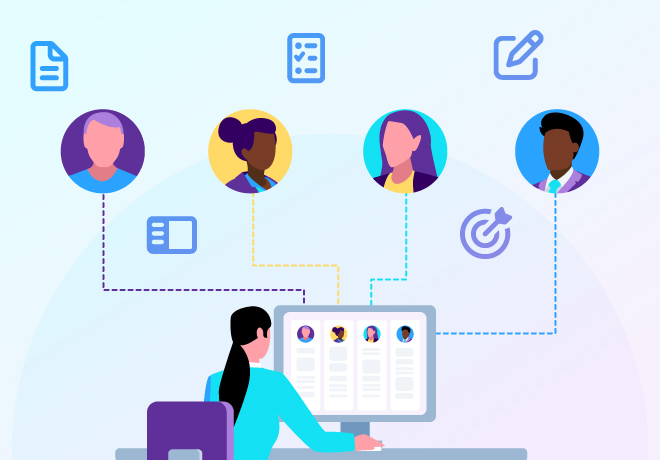

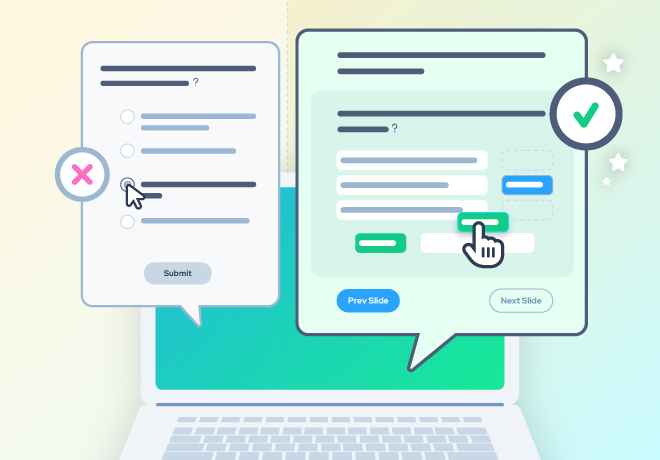
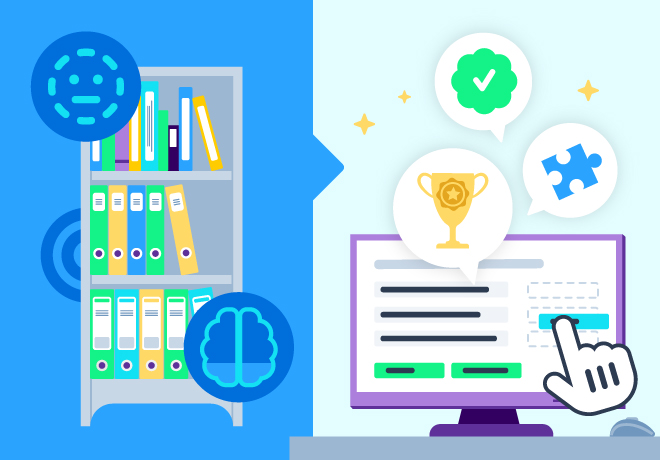
-svg.svg)
-svg.svg)
-svg.svg)
-svg.svg)